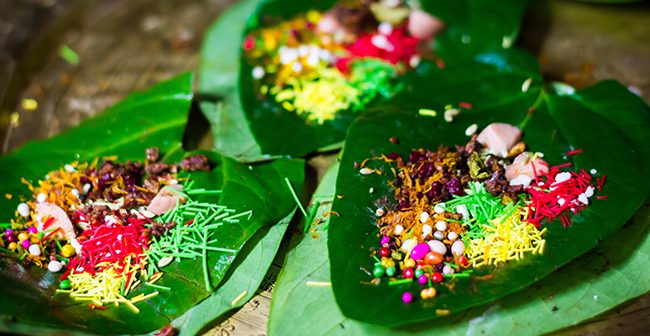The cultural significance of paan in India is vast and multifaceted, representing more than just a post-meal treat. Among the various types of paan available, Maghai Paan from Bihar stands out as a true delicacy, revered for its rich flavor, aromatic leaves, and numerous health benefits. Often associated with tradition, celebrations, and even cinema, Maghai Paan is deeply embedded in Indian culture, offering a sensory experience that is both enjoyable and beneficial.
The Legacy and Cultural Importance of Maghai Paan
Maghai Paan hails from the fertile regions of Bihar, particularly from the districts of Patna, Muzaffarpur, and Vaishali. Known for its tender, bright green leaves, Maghai Paan has been a staple in Indian society for centuries. Historically, it has been consumed by royalty and commoners alike, serving as a symbol of hospitality and social bonding. The act of offering paan, especially Maghai, during social gatherings, weddings, and religious ceremonies is seen as a gesture of goodwill and respect.
The importance of paan is also evident in Indian literature and cinema. Iconic Bollywood songs and scenes have immortalized the act of enjoying paan, with the vibrant red lips of actors after chewing paan becoming an indelible image in popular culture.
How to Enjoy Maghai Paan
Enjoying Maghai Paan is an art in itself. The process begins with selecting the finest Maghai leaves, known for their softness and lack of fibrous veins. The leaves are then smeared with slaked lime and katha (a brownish paste made from the wood of the Acacia tree), which enhance the flavor and texture.
A variety of fillings can be added depending on personal preferences and regional variations. Some popular fillings include:
- Supari (Betel Nut): Often sliced or crushed, it adds a crunchy texture and a slightly bitter taste.
- Saunf (Fennel Seeds): These seeds add sweetness and aid in digestion.
- Gulkand (Rose Petal Preserve): A sweet preserve made from rose petals, it provides a floral aroma and taste.
- Elaichi (Cardamom): Adds a hint of spice and freshness.
- Chutneys and Condiments: Various chutneys, including mint or tamarind, can be added for a tangy flavor.
- Saffron and Silver Leaf (Varq): For special occasions, saffron and edible silver leaf are used to add a touch of luxury.
Once the paan is assembled, it is carefully folded into a triangle or rolled into a cylindrical shape. The paan can be enjoyed immediately or after a meal as a digestive aid.
Types of Paan to Enjoy
India is home to a myriad of paan varieties, each offering a unique taste and experience. Some popular types include:
- Meetha Paan: A sweet version of paan, often filled with gulkand, coconut, cherries, and sugar-coated fennel seeds. It is widely enjoyed as a dessert or palate cleanser.
- Sada Paan: A simpler version, typically without the sweet fillings, focusing more on the natural flavor of the betel leaf and basic ingredients like supari, saunf, and elaichi.
- Banarasi Paan: Originating from Varanasi, this paan is famous for its aromatic flavor and is often filled with a mixture of tobacco, areca nut, and various spices. It’s considered a traditional favorite.
- Chocolate Paan: A modern twist, where the paan is coated or filled with chocolate, appealing to those with a sweet tooth and a love for fusion foods.
- Fire Paan: A trending variant where the paan is set alight before being consumed, offering a fiery spectacle and a burst of flavor.
Health Benefits of Maghai Paan
While paan is often enjoyed for its taste, Maghai Paan also offers several health benefits, provided it is consumed in moderation and without harmful additives like tobacco:
1. Aids Digestion
The combination of betel leaves, supari, and fennel seeds in Maghai Paan is known to stimulate the secretion of digestive juices, aiding in digestion. This is why paan is often consumed after meals.
2. Freshens Breath
The natural ingredients in Maghai Paan, such as cardamom, cloves, and mint leaves, act as natural breath fresheners. Chewing paan can help eliminate bad breath, leaving the mouth feeling fresh.
3. Rich in Antioxidants
Betel leaves are rich in antioxidants, which help combat free radicals in the body. These antioxidants can reduce oxidative stress, lowering the risk of chronic diseases.
4. Anti-Inflammatory Properties
Betel leaves have anti-inflammatory properties that can help reduce inflammation in the body. This is particularly beneficial for oral health, as chewing paan can help prevent gum diseases and infections.
5. Energy Boost
Supari, a common ingredient in Maghai Paan, contains alkaloids that can act as mild stimulants, providing an instant energy boost and helping to combat fatigue.
6. Improves Oral Health
The antibacterial properties of betel leaves can help maintain oral hygiene by reducing the growth of harmful bacteria in the mouth. However, it is important to note that excessive chewing of paan with tobacco or areca nut can have detrimental effects on oral health.
Conclusion
Maghai Paan is more than just a culinary delight; it is a cultural treasure that offers a unique blend of taste, tradition, and health benefits. Whether enjoyed as a simple Sada Paan or a luxurious Meetha Paan, the experience of savoring Maghai Paan is one that has been cherished in India for generations.
For those looking to explore this iconic Indian treat, Maghai Paan is widely available across India, from street-side paan vendors to high-end sweet shops. Its versatility in preparation means there is a paan for every palate, making it a must-try for anyone seeking to experience the rich flavors and cultural heritage of India.
While paan has evolved with time, incorporating modern flavors and ingredients, the traditional Maghai Paan continues to hold a special place in the hearts of Indians. Its health benefits, when consumed mindfully, add to its appeal, making it a delicious and beneficial addition to your post-meal ritual.





